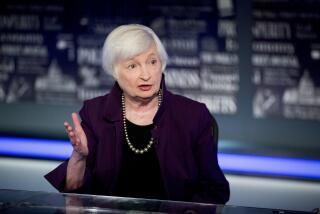Risk Management : With Bond Funds Increasingly Volatile, Ratings May Help Investors Choose
- Share via
It’s no secret that bond mutual funds have become more diverse in style, more complex--and often more risky.
Sharp interest rate swings can crash the values of bond portfolios that own even the highest-quality bonds. For example, a 1 percentage point rise in current market interest rates would cause the value of a 10-year U.S. Treasury note to drop about 6%.
Such risk was highly evident in 1994, when rising interest rates hammered many bond portfolios. Fund tracker Morningstar Inc. says the average bond fund lost 4.7% of its value in 1994--even after accounting for interest earnings. Some funds lost even more--then recouped much of their losses as rates whipsawed in 1995.
So how can you determine a bond fund’s riskiness?
One way is to check the growing number of fund “risk ratings” available. Whereas individual bond “credit ratings” track the chances of default, fund risk ratings measure how much a portfolio’s value could swing because of changes in market conditions, such as rising or falling interest rates, changes in liquidity and currency fluctuations.
Credit-rating agency Standard & Poor’s Corp., Morningstar Inc., fund families such as Vanguard Group and others have all attempted to provide investors some versions of risk ratings.
S&P; has gone so far as to petition the National Assn. of Securities Dealers, which regulates mutual fund advertising and sales, to require that all bond funds include some type of risk rating. S&P; and other credit-rating agencies stand to make big money if the NASD imposes such a requirement.
Although the requirement proposal is pending, several funds have requested that S&P; assign them risk ratings. S&P; has already assigned ratings on more than 88 bond funds holding nearly $24 billion in assets.
The S&P; ratings go from AAA--meaning the least risky--to CCC, which are expected to be the most volatile, highest-risk funds.
“A risk rating can tell investors a bit more about the volatility of the fund. It used to be all they would see was the credit-quality rating,” said Margaret Kelleher, an S&P; spokeswoman.
Based on S&P;’s ratings, risk-averse investors who are worried about interest rate volatility and loss of principal might want to consider a fund such as the Montgomery Short Government Bond fund (rated AA+ by S&P;, which means the fund has the lowest risk of any rated fund investing in mortgages).
On the flip side, Blackrock California Insured Municipal 2008 Term Trust is judged by S&P; to be a much riskier bond fund. It is rated BBB+ for risk even though it rates AAA for credit quality.
Morningstar looks at historical performance instead of creating a risk model based on future market conditions, so it doesn’t capture risks that haven’t materialized, said Mark Wright, a senior analyst with the company.
That means bond funds owning issues of lower credit quality, such as corporate junk bonds, might actually be rated as less risky because they are less sensitive to market interest rate moves over time, he said. On the other hand, funds that own long-term Treasury bonds might be judged to be higher-risk because their principal values are more sensitive to rate swings, even though there is no question about the bonds’ credit quality.
Of course, risk isn’t necessarily bad. Investors who can afford to take a chance can enjoy big payoffs.
For real risk takers, the most volatile funds obviously are the longest-term funds, in particular those owning zero-coupon Treasury bonds. That group includes Benham Target Maturities Trust Portfolio 2025 (five-year annual average return: 10.2%). If market interest rates drop next year, that fund’s value will soar.
A less risky pick, but one still quite sensitive to interest rate swings, would be the Vanguard Long-Term Corporate Portfolio (five-year average return: 9.27%), Wright said.
For investors who need income but worry that market interest rates will rise next year, a shorter-term fund is the best choice, said Wright. Investors could look at Vanguard Short-Term Corporate Portfolio (five-year average return: 6.64%). Wright also suggests the relatively new Payden & Rygel Limited Maturity fund (one-year return: 5.29%).
Not everyone agrees that fund risk ratings are a good idea. Some mutual fund managers strongly oppose S&P;’s proposal to require ratings, saying that the costs of such ratings will boost fees charged to investors. Also, critics say, ratings will only confuse investors by defining risk in one way, when risk means different things to different investors.
Even so, Securities and Exchange Commission Chairman Arthur Levitt has said investors might be helped with more information.
On the other hand, the NASD has so far avoided taking a position. S&P; petitioned the NASD to allow risk ratings two years ago, but a committee openly rejected the plan, in part because the ratings could be seen as forecasts or predictions of performance. The NASD has recently said it needs more time to study the proposal and has asked its members to comment on the plan, which critics called another delaying tactic.
John C. Bogle, founder of the giant Vanguard Group of funds, agrees that investors benefit from more information. But, like Bogle, some think a single standardized numerical measurement of risk isn’t the answer. Risk, they say, is a multifaceted concept, necessarily having different meanings for different investors. Many investors will not understand the limitations of such a measure, they say, envisioning a time when sheep-like investors may begin to rely on government-sanctioned risk ratings--to their detriment.
That’s silly, says Joan Payden, a principal with Payden & Rygel, a fixed-income management firm in Los Angeles. Payden decided this year to ask S&P; to provide risk ratings for several of the firm’s bond funds. In these markets, Payden said, investors need all the information they can get.
“Investors need to apply the same type of consumerism to their financial investments that they do to other types of purchases, like a car,” she said. “The risk ratings are really an attempt to give you some feel about liquidity, structure and the actual risk of losing principal.”
Times staff writer Debora Vrana can be reached at debora.vrana@latimes.com
(BEGIN TEXT OF INFOBOX / INFOGRAPHIC)
The ABCs of Bond Fund Ratings
A “risk rating” for a bond fund is an assessment of the fund’s rate of return variability and an analysis of key risks, including those regarding interest rate, credit, liquidity, concentration, call and option, and currency.
Here are Standard & Poor’s ratings and what they mean:
AAA: Extremely low sensitivity to changing market conditions; greatest chance for stability of returns.
AA: Low sensitivity to changing market conditions; stable returns over short and intermediate holding periods.
A: Sensitive to changing market conditions; stable returns over intermediate and long holding periods.
BBB: More sensitive to changing market conditions than higher-rated funds; greater variability of returns but adequate stability over long holding periods.
BB: Very sensitive to changing market conditions; returns can be very volatile, especially over short and intermediate holding periods.
B: Extremely sensitive to changing market conditions and may possess speculative investment characteristics; returns in these funds can be highly volatile over all holding periods.
Source: Standard & Poor’s Corp.
California Municipal Bonds
T. Rowe Price & Associates tracks the yields of 20 California municipal bonds and the Bond Buyer Index of 40 national issues.
Bond Buyer 40-bond Index
October 1996: 5.80%
*
California Index
October 1996: 5.71%
Five widely held California bonds:
Issue: California general obligation 10-year
Coupon: (generic)
Maturity: (generic)
10/25 Yield: 5.05%
Friday Yield: 4.95%
*
Issue: California general obligation 20-year
Coupon: (generic)
Maturity: (generic)
10/25 Yield: 5.70
Friday Yield: 5.60
*
Issue: Los Angeles Metropolitan Transit Authority (insured)
Coupon: 5.50%
Maturity: 7/1/2017
10/25 Yield: 5.80
Friday Yield: 5.68
*
Issue: California public works lease revenue
Coupon: 6.00%
Maturity: 10/1/2014
10/25 Yield: 5.80
Friday Yield: 5.70
*
Issue: San Francisco airport (insured)
Coupon: 5.65%
Maturity: 5/1/2024
10/25 Yield: 5.85
Friday Yield: 5.75
*
Source: T. Rowe Price & Associates in Baltimore, which manages a $150-million California bond fund.
Note: All yields are as of 2 p.m. Friday. Yields are based on institutional trading, retail prices and a survey of California brokers. Yields offered to individual investors will vary.
More to Read
Inside the business of entertainment
The Wide Shot brings you news, analysis and insights on everything from streaming wars to production — and what it all means for the future.
You may occasionally receive promotional content from the Los Angeles Times.










